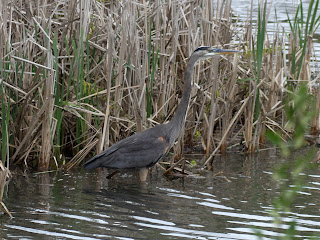Heron Cousins Go Fishing
Last May at Washington Valley Park I met bird cousins who were both fishing there (though not together). They were a Great Blue Heron and a Great Egret. They are usually placed in the same genus (Ardea); the Great Blue Heron is always placed there, though some ornithologists place the Great Egret with other white-plumaged herons. I'm going with the more mainstream classification where they're in the same genus, which makes them each other's closest relative living in New Jersey.
The Great Blue Heron definitely has closer relatives elsewhere. The Grey Heron of Eurasia/North Africa is easily confused with it ... except for that different-parts-of-the-world thing. (If you think you see a Great Blue Heron on your trip to Europe, you're more likely to be seeing a Grey Heron.) They're both also considered very close relatives of Cocoi Heron of South America [1].
The Great Egret is slightly shorter, considerably lighter, and lacks the head plumes of the typical Great Blue Heron. While plumage color along differentiates them here in New Jersey, down in Florida there is a Great White Heron that is all white and is usually considered a morph of the Great Blue Heron [2]. Down south it's definitely more complicated when telling these species apart. Our Great Egrets also have close relatives around the world, though in their case those relatives are considered subspecies.
Both these birds fish in approximately the same way, wading slowly until they see a meal, at which point they make a lightning-fast strike with their bills. And despite their kinship, both tend to be solitary fishing birds; I don't normally even see them with their own species.
The picture of the Great Egret also showed a watchful Red-winged Blackbird. I've seen Red-winged Blackbirds dive bomb Great Blue Herons, though I suspect that was when they had nearby nestlings. Though both Great Blue Herons and Great Egrets eat mostly aquatic prey like fish and frogs, they'd have no qualms about eating small birds if the opportunity presented itself.
 |
| May 1, 2023 at Washington Valley Reservoir Photo 278270611, (c) jpviolette, some rights reserved (CC BY-NC) |
 |
| May 1, 2023 at Washington Valley Reservoir Photo 278271693, (c) jpviolette, some rights reserved (CC BY-NC) |
[1] These 3 birds do occasionally show up in 1 another's territory, presumably after getting blown off course and getting lost. The article on Grey Herons suggests that they can interbreed, so a lost individual won't necessarily live a lonely life without a family.
[2] The classification of the Great White Heron doesn't have unanimous agreement, with some thinking it should be a distinct subspecies, and a few mavericks who think it should be an entirely different species.



Comments
Post a Comment